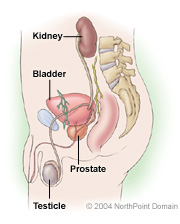Biopsy is a minor surgical procedure in which a physician removes a sample of tissue from a specific area, and then has a pathologist examine and identify the cells in the tissue to diagnose a cell mass or tumor. The most common biopsy performed by urologists diagnoses prostate cancer. Other conditions for which a physician may recommend a biopsy include:
- Bladder cancer;
- Kidney cancer; and
- Testicular cancer.
A physician may recommend one of the following common types of biopsies:
- Core needle biopsy;
- Fine needle aspiration; or
- Transurethral biopsy.
PRE-TEST GUIDELINES
Instructions for patients having a biopsy may be different for each type of biopsy. The patient’s physician will give specific pre-treatment guidelines where necessary.
WHAT TO EXPECT
Core needle biopsy. The physician inserts a hollow, spring-loaded needle into the prostate gland from an area between the anus and scrotum or through the rectum. With ultrasound guidance, the physician collects tissue samples called cores with the needle from several places in the prostate.
Fine needle aspiration. Biopsy using a very thin needle is a faster, less-invasive method of collecting cells. Cells from a suspicious area in the prostate are drawn up through the thin needle and then examined under a microscope.
Transurethral biopsy. During the procedure, a cystoscope is inserted through the urethra to the bladder. A cutting loop is inserted through the cystoscope to the site of the suspected mass and is rotated to collect tissue samples.
POST-TREATMENT GUIDELINES
Core needle biopsy. Following a core needle biopsy, a patient can resume normal daily activities.
Fine needle aspiration. For kidney biopsy, a patient may remain in the hospital overnight. For 2 weeks following the biopsy, patients will be instructed to:
- Avoid heavy lifting;
- Avoid strenuous exercise; and
- Avoid sexual intercourse.
Transurethral biopsy. Following the biopsy, the patient is sent home once he or she urinates.
POSSIBLE COMPLICATIONS
Core needle biopsy. Complications may include infections and bleeding.
Fine needle aspiration. Complications may include:
- Bruising;
- Tenderness; or
- Infection (extremely rare).
Transurethral biopsy. Complications may include:
- Bladder damage;
- Damage to muscles around the urethra (rare);
- Scarring, which may cause the urethra to narrow (called urethral stricture); or
- Infection.


